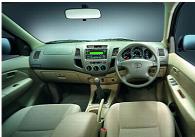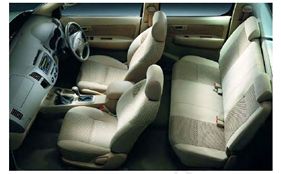![]() | Sam 4x4 | About | 4x4 Vehicles | Accessories |
Executives |
Testimonials |
Mission | Links | Contact |
| Sam 4x4 | About | 4x4 Vehicles | Accessories |
Executives |
Testimonials |
Mission | Links | Contact |
![]()
Toyota Hilux Vigo | Mitsubishi L200 Triton | Nissan Navara | Toyota Fortuner | DMax | Chevy Colorado | Ford Ranger
Thailand 4x4 pickup SUV exporter importer of RHD LHD New 2009 2008 and Used Toyota Vigo, Toyota Fortuner, L200 Triton, and Nissan Navara
Toyota Hilux Tiger
Sam Motors Thailand and our parent company Sam Auto Group Thailand are world's largest exporter of Toyota Hilux Vigo and Toyota Hilux Tiger. Email us now at thai4x4@gmail.com for either a quality pre-owned Toyota Hilux Tiger, Toyota Hilux Sportsrider, Toyota Hilux Sportscruiser or Toyota Hilux Vigo. We have exported different version of old and new Hilux to over 100 countries in the world. We can sell you either from Thailand or from Dubai via our Dubai branch: Sam Motors Dubai. More detailed Toyota Hilux Tiger specs are at http://www.sam4x4.com/toyota-tiger.html.
Contents
- Hilux Tiger Intro
- Hilux Sportsrider
- Hilux Tiger Specifications
- Hilux Exterior
- Hilux Interior
- Metallic Colors
- Accessories
- Modified LHD
Hilux Tiger & Sportscruiser Intro
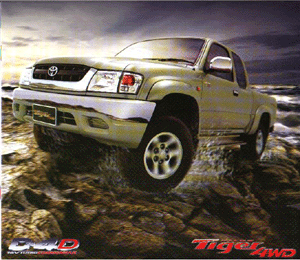 Sam Motors as Thailand's
oldest and largest exporter of
automobiles receives emails and calls from every country in the world.
Almost 80% of these queries are regarding importation of
Toyota Hilux Vigo if they are looking for a new vehicle, or
Toyota
Hilux Tiger or
Toyota Hilux Sportscruiser if they want a pre-owned vehicle - in
their respective countries. This should give us a sense of Hiluxes
worldwide popularity.
Sam Motors as Thailand's
oldest and largest exporter of
automobiles receives emails and calls from every country in the world.
Almost 80% of these queries are regarding importation of
Toyota Hilux Vigo if they are looking for a new vehicle, or
Toyota
Hilux Tiger or
Toyota Hilux Sportscruiser if they want a pre-owned vehicle - in
their respective countries. This should give us a sense of Hiluxes
worldwide popularity.
The first Vigo rolled out of the assembly line in August 2004. Hilux that preceded Hilux Vigo was named Hilux Sports Cruiser and was produced from year 2000 to end of 2004. Before then, Hilux Tiger dominated the landscape from 1990 to the year 2000. HILUX TIGER comes without TURBO, 3.0 L Diesel EFI ENGINE with Manual Transmission 4wd only, and the version available in gear manual 2.5 L is with TURBO (all models) in 4wd and starts from the year 2001 in the D4d 2KD engines.
Toyota had been building cars and trucks in Thailand since 1956 and now owns three major assembly plants here, with vehicles and parts being exported to other countries. It was with the Hilux Tiger, that Toyota decided to make Thailand the hub of its manufacturing: instead of exporting Hilux from its Japanese plant, it made a strategic shift by exporting it to Australia from its Thai plant. Vigo is now being exported worldwide.
The Hilux Sportscruiser was nearly identical to most other Hiluxes of its generation, with the exception that it uses the newer D4D engine, not found in Australia, New Zealand and South African markets.
Hilux Sportscruiser are available from 2001 till 2004. In early 2001 Hilux Tiger still came in 5L engine, later in the year Toyota released it in Prado's 1KZ engine only to change its mind and release it in D4D in late 2001. The early 2001 model is TOYOTA SR5 3.0 L EFI Engine, 4 doors, 4x4 Manual Transmission, and standard options are, AIRBAG (Driver Side only), ABS Brakes, Power Steering, Power Windows, Electric Side Mirrors, Cassette Player/Radio AM FM, Fabric Seatings, A/C (No Heater). Please note that SR5 3000cc diesel manual only came in 2000 and 2001.
The model that succeeded SR-5 was 4x4 4door with 1KZ engine. This was in 3000 cc and in years 2001 and 2002. Then from the end of 2001 to 8th month of 2004 2500 cc manual came with D4D engine. 3000 cc D4D came in Auto from the end of 2001 and lasted till 8th month of 2004
The D4D COMMONRAIL Diesel TURBO Engine used in the new Hilux Vigo was first introduced in Hilux Tiger Sportcruiser.
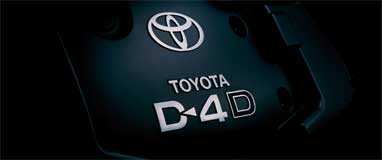 D-4D
actually stands for direct Injection 4 Cylinder Common Rail Diesel Engine.
Common rail diesels inject a fine mist of fuel into the engine at very high
pressure. The result is the same power and refinement as a petrol engine, but
with better fuel efficiency and lower emissions.
D-4D
actually stands for direct Injection 4 Cylinder Common Rail Diesel Engine.
Common rail diesels inject a fine mist of fuel into the engine at very high
pressure. The result is the same power and refinement as a petrol engine, but
with better fuel efficiency and lower emissions.
Toyota D-4D engines are not just noteworthy for their smooth, linear torque, though: that's a characteristic of most modern diesel engines. What D-4Ds are noteworthy for is their unusually high power outputs, equivalent to that of many competitors' similarly-sized petrol engines. The D-4D's rev range is also usefully wider than normal, further enhancing the driving experience.
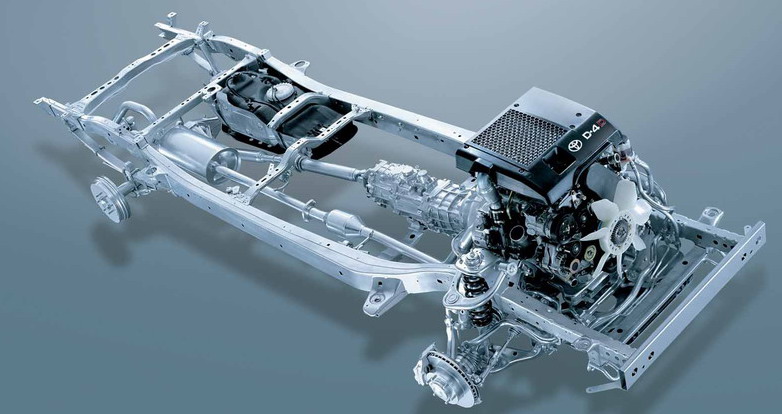
best Platform (Toyota Outstanding Platform)
The Hilux Vigo range is powered by either Toyota’s 16-valve 2.5-litre D-4D direct injection common rail turbodiesel engine, delivering 102bhp & 300Nm/2,000 or the 16-valve 3.0-litre D-4D direct injection common rail turbodiesel engine, delivering 163bhp & 343Nm/1,400-3,400.
The 3.0 litre D-4D Common Rail Turbo Diesel 1KD-FTV- already among the most powerful and torquey in the sector - is carried over from the legendary Land Cruiser and offers enormous torque with excellent fuel consumption.
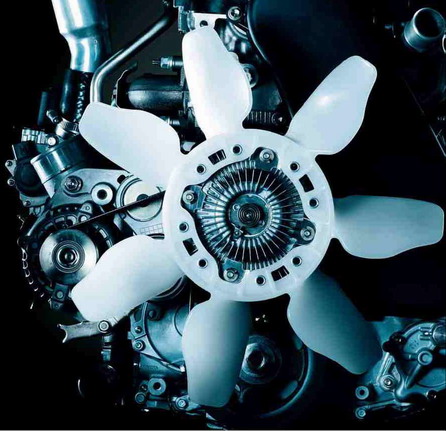
The engine develops 120kW (163D|N hp) at 3,400rpm with torque of 343Nm across an engine speed range of 1,600 to 3,200rpm. Maximum speed is 106mph (170km/h) with manual transmission and acceleration from 0-62mph is under 12.7 seconds.
The Hilux Tiger is not compromised in its load-carrying ability, it has an impressive gross vehicle weight. It is a workhouse in factories and farms all around the world. Farmers in South Africa, Namibia, Angola and Pakistan are as satisfied with their Hiluxes exported by Sam Motors, as are small business owners in UK, Norway, Denmark, Spain and Latin America.
Hilux Sportsrider
 Toyota manufactured
several unique models in Thailand, including the Sport-Rider, among
others. Sports Rider was a pickup and SUV built on Hilux
platform.
Toyota manufactured
several unique models in Thailand, including the Sport-Rider, among
others. Sports Rider was a pickup and SUV built on Hilux
platform.
Here is a picture of 2004 Sports Rider which represented the end of an era. It has now been replaced by Toyota Fortuner. In Thailand, Sportsrider is available as a pickup as well.
5L-E and 1KZ-TE Engine
After hanging on to the aging 5L engine for sometime, market pressure had forced Toyota to come up with a superior engine for its sports utility line-up.
With customers demanding for better performance than the normally-aspirated 5L engine could offer, Toyota decided to install a new engine to the Hilux Tiger SR5 4x4 pick-up as well as the Sport Rider sport utility vehicle. The new engine, the turbo-charged 1KZ-TE, as well as the 5L-E (basically the 5L engine with electronic fuel management) engine both passed the strict Euro II emission standard. But most importantly, the 1KZ-TE motor offered significantly increased output with 125 ps (SAE Gross) at 3,600rpm and a massive 315Nm (EEC net) of torque at 2,000rpm.
There was initially confusion over the horsepower output of the new engine, because it was measured in SAE Gross instead of the regular EEC net due to marketing reasons. Otherwise, the maximum power of the 1KZ-TE engine would be about 116 horsepower. Nevertheless, it was a brilliant powerplant capable of giving the SR5 tremendous performance uncommon in the pick-up truck segment. Note that this engine also powered other vehicles in the Toyota line-up including the Land Cruiser Prado and the Granvia van.
Acceleration had been improved dramatically over the 5L engine and the Tiger SR5 was the quickest pick-up in the market with a best speed of almost 160km/h. Thanks to the huge amount of torque, it took no time to accelerate from cruising speed to the truck's best speed. The gearbox did not require much force at all if you shift with the right timing. But during full acceleration, it tends to get stubborn and the extra time needed to shift results in lower acceleration figures.
The four-wheel-drive system was easy to use, and the ADD (automatic disconnecting differential) function with shift on the fly allows the driver to switch between two and four-wheel-drive without having to sbest the vehicle. The front torsion bar and rear leaf spring suspension of the Tiger SR5 is average in terms of comfort. It has been tuned for off-road driving and in this department it is one of the best. With the high torque, the Tiger SR5 climbs up gradients comfortably. Toyota claims that it could climb at 46.5 degrees and has approach/departure angles of 36 and 25 degree respectively.
Brakes are vented discs in front and drums at the rear. There are also a Super LSPV (load sensing proportioning valve) and LTS (leading trailing system) systems to improve stopping performance. The cabin is comfortable and neatly designed. The speedometer, tachometer, and gauges in the dash have white background while the steering is a four-spoke type.
Among the highlights in the Tiger SR5us equipment list are driver airbag, seat belts with pretensions and force limits, laminated glass, and a four-sensor ABS system. Other standard features include power windows, power mirrors, central locking, radio-cassette player, fabric seat covers, and 15-inch alloy wheels with large 255/70 tires.
Toyota had managed to make a strong comeback with an outstanding product like the Tiger SR5 1KZ-TE and it broke records of previous sale until Toyota Vigo changed history by its unprecedented reception.
5L-EFI Engine
The 5L-E is a 3.0 L (2986 cc) EFI version of the 5L engine. It is the latest member of the L family. It has a bore of 99.5 mm and stroke of 97 mm, with a compression ratio of 22.2:1. Output is 97.5 hp (72 kW) at 4000 RPM with 141.6 ft·lb (192 N·m) of torque at 2400 RPM.
Hilux Tiger Specifications
|
|
|
mm |
mm |
mm |
mm |
kg |
ps |
|
Series |
MODEL |
L |
W |
H |
W.B |
Wei-ght |
HP(Net) |
|
Hilux Tiger Extra Cab C-CAB(4x2) |
3.0 SGL auto |
4975 |
1690 |
1625 |
3085 |
1426 |
97/ 4000 |
|
3.0 SGL |
1625 |
1410 |
97/ 4000 |
||||
|
3.0 GL |
1610 |
1410 |
97/ 4000 |
||||
|
2.4 GL |
1610 |
1410 |
85/ 4200 |
||||
|
Hilux Tiger Single Cab B-CAB(4x2) |
3.0 GL |
4840 |
1690 |
1605 |
2690 |
1370 |
97/ 4000 |
|
2.4 GL |
4840 |
1690 |
1370 |
85/ 4200 |
|||
|
2.4 Economy |
4840 |
1690 |
1370 |
85/ 4200 |
|||
|
2.4 GL |
4730 |
1690 |
1335 |
85/ 4200 |
|||
|
Hilux Tiger Sports PickUp |
PRE-RUNNER (4x2) |
4860 |
1690 |
1795 |
2660 |
1490 |
97/ 4000 |
|
GL (4x4) |
1600 |
97/ 4000 |
|||||
|
SR5 (4x4) |
1600 |
97/ 4000 |
|||||
|
Sports Rider |
PRE-RUNNER(4x2) |
4590 |
|
1775 |
2860 |
1730 |
97/ 4000 |
|
SR5 (4x4) |
4590 |
1775 |
1775 |
1840 |
|||
|
SR5 LTD (4x4) |
4985 |
1775 |
1795 |
1875 |
|
Series |
Model |
P/ S |
P/ W |
ABS |
Air |
Ra- |
Auto Mir-ror |
Cen-ter |
|
Hilux Tiger Extra Cab C-CAB(4x2) |
3.0 SGL auto |
O |
O |
O |
|
O |
O |
O |
|
3.0 SGL |
O |
O |
O |
|
O |
O |
O |
|
|
3.0 GL |
O |
|
|
|
O |
|
|
|
|
2.4 GL |
X |
|
|
|
O |
|
|
|
|
HILUX TIGER SingleCab B-CAB(4x2) |
3.0 GL |
O |
|
|
|
O |
|
|
|
2.4 GL |
|
|
|
|
O |
|
|
|
|
2.4 Eco-nomy |
|
|
|
|
O |
|
|
|
|
2.4 GL |
O |
|
|
|
O |
|
|
|
|
HILUX TIGER Sport PickUp |
PRE-RUNNER (4x2) |
O |
O |
O |
O |
O |
O |
O |
|
GL (4x4) |
O |
|
|
|
O |
|
|
|
|
SR5 (4x4) |
O |
O |
O |
O |
O |
O |
O |
|
|
Sports Rider
|
PRE-RUNNER (4x2) |
O |
O |
O |
O |
O |
O |
O |
|
SR5 (4x4) |
O |
O |
O |
O |
O |
O |
O |
|
| SR5 (limited) |
O |
O |
O |
O |
Series
Model
DEF
GOA
T.R.
F.T.
Hilux Tiger Extra Cab C-CAB(4x2)
3.0
SGL
auto
O
5.9
69
3.0
SGL
O
3.0
GL
O
2.4
GL
O
HILUX TIGER
SingleCab B-CAB(4x2)
3.0
GL
O
5.8
69
2.4
GL
O
6
2.4
Eco-nomy
O
6
2.4
GL
O
5.7
HILUX TIGER
Sport PickUp
PRE-RUNNER (4x2)
O
6.1
71
GL (4x4)
O
SR5 (4x4)
O
Sports
Rider
PRE-RUNNER (4x2)
O
O
6.6
71
SR5 (4x4)
O
O
ltrs
SR5 (limited)
|
Legends:
|
|
DIMENSIONS & WEIGHT |
|
|
STANDARD FEATURES Radio AM/FM Digital Clock Alloy Wheels Green Laminated W/shield Vinyl Seat |
|
Overall length |
mm. |
4730 |
|
|
Overall width |
mm. |
1690 |
|
|
Overall height |
mm. |
1795 |
|
|
Wheelbase |
mm. |
2860 |
|
|
Tread Front/Rear |
mm. |
1485 / 1470 |
|
|
Ground clearance |
mm. |
225 |
|
|
Seating Capacity |
|
2 |
|
|
CHASSIS |
|
|
SAFETY FEATURES Fr. Seat Belts Child Protection Lock Retractable Bumpers GOA Body Structure |
|
Suspension |
Front |
MacPherson strut type suspension |
|
|
Rear |
Double wishbone suspension |
||
|
Brakes |
Front/Rear |
Discs/Drums |
|
|
Min. turning radius (tyres) |
m. |
6.6 |
|
|
Fuel tank capacity |
litres |
71 |
|
|
Tyres |
|
255/70R15 |
|
|
Drive System |
|
4-wheel |
|
|
ENGINE |
|
|
POWER FEATURES Power Steering Power Window Front Power Door Lock Air Cooler |
|
Type |
|
5l-E, OHC |
|
|
Piston displacement |
cc. |
2986 |
|
|
Max. Output |
Kw/rpm |
71/4000 |
|
|
Fuel System |
|
Electronic Fuel Injection |
|
|
Max. Torque. |
Nm/rpm |
200/2600 |
|
Hilux Interior |
||||
|
Modified LHD Vehicle
Following Hilux Vigo was converted from RHD to LHD by expert Thai craftsmen with original LHD vehicle parts and accessories. Can you tell the difference? Our customer in Europe is very satisfied with the result. We can also convert a Hilux Tiger or SportsRider to your specifications.
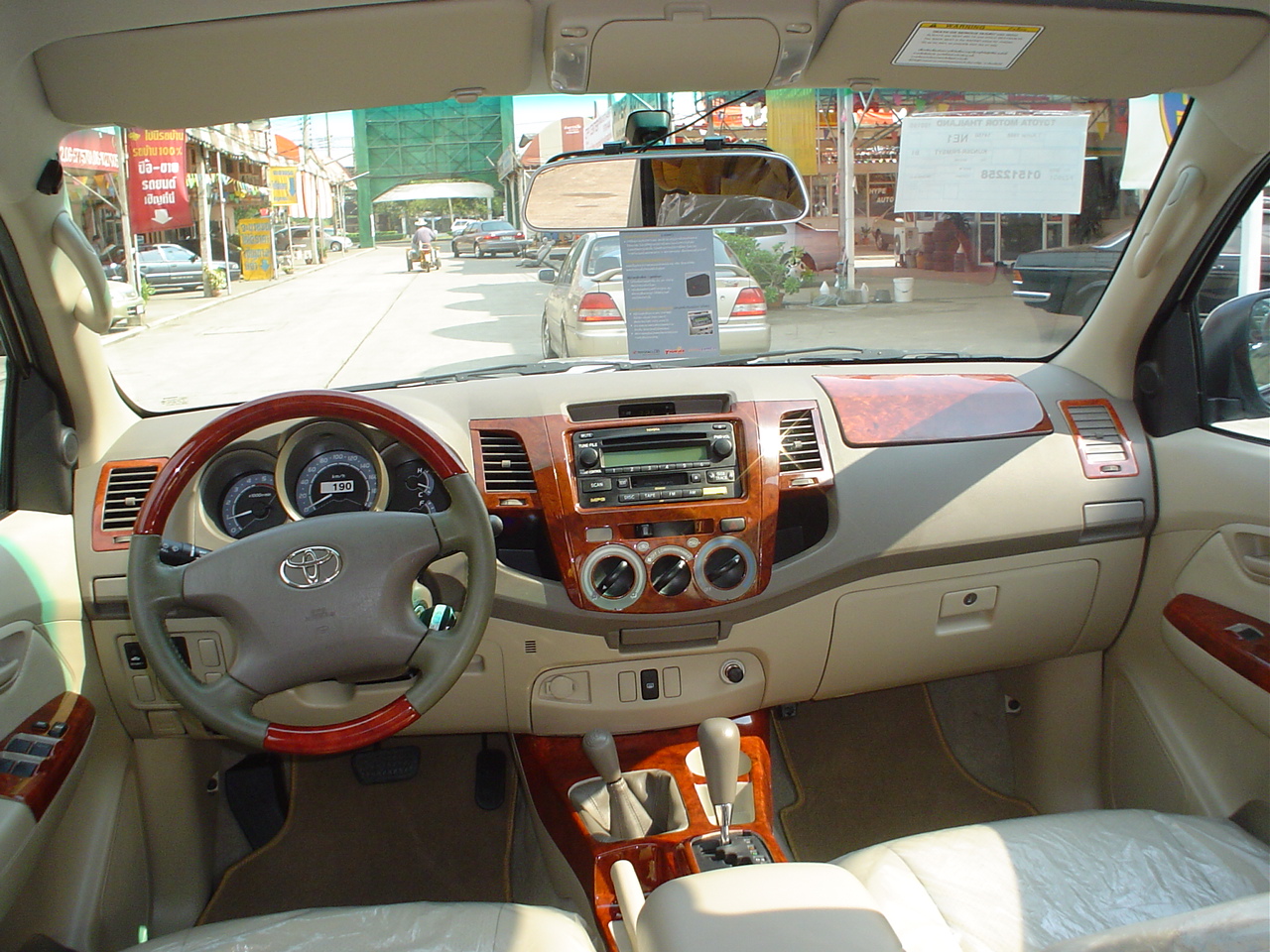
 |
 |
 |
| Return to our page on Toyota Hilux Vigo | Return to Index Page | Email us now at thai4x4@gmail.com |
Glossary
A
ABS (Anti-lock Braking System)
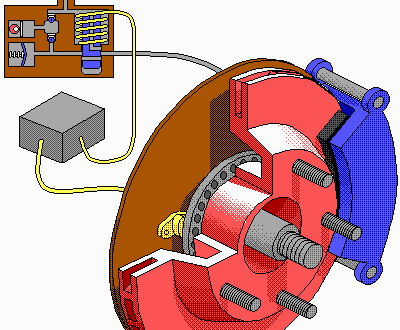 The acronym ABS comes from the German anti blockier system. Antilock braking systems (ABS) use electronic controls to
maintain wheel rotation under hard braking that would otherwise lock
a vehicle's wheels. Keeping the wheels rotating increases vehicle
stability, especially when tire/roadway friction is reduced or
varying, as when the roadway is wet.
The acronym ABS comes from the German anti blockier system. Antilock braking systems (ABS) use electronic controls to
maintain wheel rotation under hard braking that would otherwise lock
a vehicle's wheels. Keeping the wheels rotating increases vehicle
stability, especially when tire/roadway friction is reduced or
varying, as when the roadway is wet.
What it is: ABS keeps the wheels from fully locking up while braking to allow the driver to maintain steering control. Without ABS, too much force applied to the brake pedal can cause one or more wheels to sbest turning (lockup) and begin skidding, greatly reducing the capability of the driver to steer. With ABS, maximum force on the brake pedal slows each wheel to the point of maximum braking - without skidding.
Since all wheels are still rolling, the driver maintains steering control within the limits of traction. Many light trucks use rear-wheel ABS to prevent rear wheel lockup.
How it works: ABS is one of the most important automotive safety advancements since the seat belt, but it's also one of the least understood. ABS consists of an electronic control unit (ECU) with microprocessor, hydraulic control unit (HCU) with pump and motor (to modulate brake line pressure), and wheel speed sensors for each wheel. if a wheel begins to lock up during braking, the computer senses a speed difference compared to the other wheels. The HCU reduces pressure to that brake until it begins to roll again. This occurs many times per second during braking, making pumping of the brakes unnecessary. When the brake is applied firmly, each wheel is kept at maximum braking without locking up to help the driver make the best use of available traction.
Conventional Brakes vs. ABS: If you push the conventional brake pedal hard when stopping on loose or slick surfaces, one or more of the wheels may lock up--sbest turning. The lock up can cause the vehicle to swerve or skid, leaving you with little or no control of the vehicle. On the other hand, with an anti-lock brake system, a sensor in an about-to-be locked up wheel sends a message to a computer. The computer in ECU immediately starts releasing and applying that brake, killing the lock-up and allowing you to maintain control -- or drive around an obstacle instead of sliding straight towards it.
One important thing to remember--when the anti-lock system kicks in, it makes a noise and the brake pedal pulsates. If that happens, keep your foot on the brake pedal and let the anti-lock system go to work. Letting up on the pedal may turn off the anti-lock system.
An Anti-Lock Bonus Engineers found they could use the same system to detect and control wheel spin on acceleration, resulting in the traction control systems that are available on many newer models.
Customer benefit: ABS provides the average driver with greater vehicle stability and control during severe braking, allowing the driver to steer away from a potential accident.
Alloy wheels
Wheels usually made of aluminum alloy; installed to improve appearance. Alloy wheels are less prone to corrosion and can be significantly lighter than the equivalent steel wheels.
Automatic Disconnecting Differential (A.D.D.)
ADD uses an actuator at the front differential, which connects the front differential in 4WD modes (h3 & L4), and disconnects in 2WD (H2).
Automatic Locking Retractor/Emergency Locking Retractor (ALR/ELR) Seatbelts
ALR Makes it possible to secure a baby seat without using a seat-belt locking clip. To activate the ALR retractor, pull the shoulder belt all the way out then allow it to retract to the desired length, where it locks firmly and stays locked. ALR belts are located where a child's seat would be located. To reset the ALR belt, simply pull the belt out and release it. Since these positions can also be occupied by other passengers, the ALR belts are actually hybrid ALR/ELR types, which combine the best features of each.
ELR allows the belt to extend and retract with occupant movement, yet locks the belt during a sudden sbest or upon impact.
Automatic Transmission
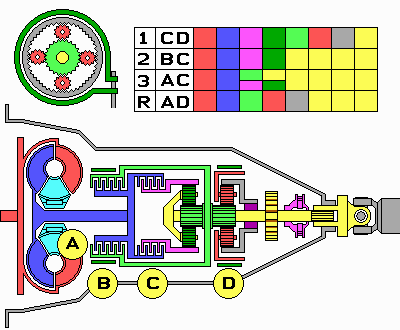 A transmission that shifts its own gears according to the
prevailing speed, load, and road condition. Also called automatic
gearbox. Operation can be electrical or hydraulic.
A transmission that shifts its own gears according to the
prevailing speed, load, and road condition. Also called automatic
gearbox. Operation can be electrical or hydraulic.
The transmission transfers the engine's power from the crankshaft to the driveshaft (which, in turn, sends it on to one or more axles and the driving wheels). An automatic transmission does this using a torque converter rather than a manually operated clutch. A torque converter uses hydraulic pressure to engage and disengage the transmission gears from the engine. Some automatic transmissions have three speeds; more sophisticated versions have four with the fourth gear acting as the overdrive to help reduce engine rpm. (A few ultra-expensive exotic cars have five-speed automatic transmissions.)
Benefit: An automatic transmission allows the driver more comfort and ease of use than a manual transmission, particularly in urban and stop-and-go driving situations. (See also Electronically Controlled Automatic Transmission [ECT], Gear Ratio and Automatic with Overdrive.)
Automatic with overdrive
OVERDRIVE: (1.) A device attached to or incorporated in a transmission that allows the engine to turn less than one full revolution for every complete revolution of the wheels. The net effect is to reduce engine rpm, thereby using less fuel. A typical overdrive gear ratio would be .87:1, instead of the normal 1:1 in high gear. (2.) A gear assembly which produces more shaft revolutions than that transmitted to it.
Vigo's best gear acts as the overdrive to help reduce engine rpm. This best gear delivers quieter, more economical driving. On some automatic models, an off switch keeps the transmission in third at highway speeds for more engine braking when driving downhill or for more power when towing
Axle Ratio
The number of times the driveshaft revolves to turn the axle one revolution. For example, a 4:1 axle ratio means the drive shaft turns 4 times for every one time the tire turns. This ratio multiplies the torque applied to the wheels.
B
Bore and Stroke
These are two separate measurements of the area of the combustion process in an individual cylinder. The bore is the diameter of the cylinder and the stroke is the total distance the piston travels within the cylinder from best to bottom. The area of the cylinder, multiplied by the stroke, times the number of cylinders, equals the engine's total displacement.
Brake Horsepower (BHP)
The measure of an engine's horsepower without the loss in power caused by the inefficiencies in the accessories and drivetrain
C
Cam
A lobe-shaped portion of the camshaft that actuates the valve mechanism
Camshaft
A shaft in the engine used to operate the intake and exhaust valves. It is driven from the crankshaft by gears, belts or chains and opens and closes the valves as it rotates. The camshaft is located in the engine block in a pushrod overhead-valve (OHV) engine where the cam lobes operate pushrods that, in turn, operate the valvetrain. A camshaft located in the best of the cylinder head is referred to as an overhead camshaft. There can be either one (single overhead camshaft or SOHC) or two (dual overhead camshaft or DOHC) camshafts per row of cylinders
Cargo Weight Rating
Includes payload rating minus the weight of all occupants at a weight of approximately 180 lbs. a person. What you need to know: Vehicles that operate above the Payload rating are a potential safety hazard because the engine, frame, suspension, brakes and tires are not designed for weight above the rating the manufacturer has set.
Chassis [Pronunciation: chassie]
The structural elements of a vehicle. A unibody chassis includes everything but bolted-on body panels. If a vehicle has a separate frame, the term chassis refers to the frame.
Compact Disc Changer
Usually mounted in the vehicle's trunk, the changer is a player that contains a cartridge holding from six to 12 discs, depending upon the model. Some vehicles have in-dash, single feed, 6 disc changers. Benefit: This has the advantage of playing several hours of music without requiring any further action. Most changers also include a "random" mode that will randomly switch from one song to another among the discs, thus varying the music played
Crew Cab
Crew Cab is the term Chevy, GMC, and Nissan all use to describe their four-door trucks. Also Known As: Quad Cab (Dodge), Double Cab (Toyota), SuperCrew (Ford)
Collapsible Steering column
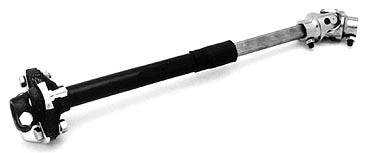 Before
1978, many cars had rigid steering wheels and columns that could
crush a driver’s chest during an accident. One of the first safety
features to come down the pike after seatbelts and padded dashboards
was the collapsible steering wheel and column.
Before
1978, many cars had rigid steering wheels and columns that could
crush a driver’s chest during an accident. One of the first safety
features to come down the pike after seatbelts and padded dashboards
was the collapsible steering wheel and column.
What makes a collapsible steering column safer is the crush zone, wrapped in plastic in the figure on the left. It is designed to collapse during a collision when the driver’s body collides with the steering wheel and column. A tube and steering shaft inside collapse as well, taking the blow instead of the body.
The steering column is divided into two separate sections, and these sections are joined with a sleeve made from relatively thin sheet metal. When a driver's chest impacts the steering wheel, the sleeve crumbles thereby reducing the forces on the driver's chest. This very simple, reliable, and inexpensive device causes a 6.6% reduction in driver fatality risk which is two thirds that of the 10% reduction from airbags. The collapsible steering column, unlike the airbag, is a passive device in that the user does not have to know anything or take steps, such as avoiding being close to it. Indeed, few users even know it is there.
Commonrail
The turbocharger has already done much to transform the diesel engine from a hardworking but slow-moving beast of burden into a respectable power source. In fact, any decent turbodiesel will produce much more torque than a petrol engine of equivalent capacity.
The common rail takes the diesel even further, so much so that the latest European diesels can rival petrol engines in power while far outstripping them in torque.
The simplest way to understand this relatively new innovation is to think of it as a turbocharger for fuel, in that the common rail forces diesel fuel into the engine under pressure (about eight times higher than that generated by a conventional fuel pump), just as a turbo pumps in air under pressure. Common rail diesels inject a fine mist of fuel into the engine at very high pressure. The result is the same power and refinement as a petrol engine, but with better fuel efficiency and lower emissions.
 The theory
behind Commonrail was originally developed by researchers at Zurich
University. This simple yet elegant theory is based on the
assumption that if you continue to push diesel into a tank, the
pressure inside will rise and the tank itself will become a
hydraulic accumulator (or rail), i.e. a reserve of pressurised fuel
ready for use. Croma TDI,
the first direct injection diesel vehicle in the world was released
in 1988. This allowed lower fuel consumption, efficient combustion
and improved performance. One problem remained: excessive engine
noise at low rpms and during speed transients.
The theory
behind Commonrail was originally developed by researchers at Zurich
University. This simple yet elegant theory is based on the
assumption that if you continue to push diesel into a tank, the
pressure inside will rise and the tank itself will become a
hydraulic accumulator (or rail), i.e. a reserve of pressurised fuel
ready for use. Croma TDI,
the first direct injection diesel vehicle in the world was released
in 1988. This allowed lower fuel consumption, efficient combustion
and improved performance. One problem remained: excessive engine
noise at low rpms and during speed transients.
The quest for a more advanced direct injection system that could drastically reduce the problem of excessive combustion noise led to Unijet commonrail technology. Despite the name, 'Unijet', the engines made not one but two diesel injections into the combustion chamber, a small initial injection and a bigger main injection. In October 1997, nine years after the Croma TDI, the market welcomed another record-breaking car: the Alfa 156 JTD built on Unijet technology. The new model was equipped with a revolutionary turbodiesel engine that was to deliver previously unimaginable results.
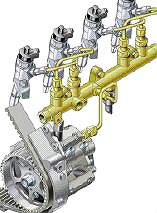 Recently, the second-generation of
Common Rail power units that are multijet, i.e. capable of multiple
injections (3 to 5 in fact), have begin to make their appearance.
Recently, the second-generation of
Common Rail power units that are multijet, i.e. capable of multiple
injections (3 to 5 in fact), have begin to make their appearance.
The engineering principle behind both systems is the same. Even in the Unijet version, the pilot injection raises temperature and pressure inside the cylinder to improve combustion at the time of the main stroke. Because the main injection can now be divided into many smaller injections, the amount of diesel burnt inside the cylinder remains the same but combustion is fuller and more gradual. This allows further progress towards the aim of quieter combustion, reduced emissions and increased performance.
Multijet Common Rail engines differ
from Unijet Common Rail engines in two essential parts: the
injectors and the electronic control unit (ECU). Injections that can
reduce the time between one injection and the next were required to
increase the number of injections. able to modulate injection
strategy continually to adjust to changes in three parameters:
engine rpm, torque required at any given moment by the driver and
coolant temperature.
While the new Multijet engine is in operation, the control unit
continually adjusts injection arrangement and number (as well as the
amount of diesel injected).
Cubic Centimeter (What cc is your car?)
Hilux Vigo comes either with 2500 cc or 3000 cc engine. To understand this, some background is in order. The combustion chamber is the engine area where compression and combustion take place. As the piston moves up and down, the size of the combustion chamber changes. It has some maximum volume as well as a minimum volume. The difference between the maximum and minimum is called the displacement and is measured in liters or CCs (Cubic Centimeters, where 1,000 cubic centimeters equals a liter).
Vigo has a 4-cylinder engine, when each cylinder displaces 0.625 of a liter, then the entire engine is a "2.5 liter engine" and when each cylinder displaces 0.75, you have a "3.0 liter engine."
Generally, the displacement tells you something about how much power an engine can produce. A cylinder that displaces half a liter can hold twice as much fuel/air mixture as a cylinder that displaces a quarter of a liter, and therefore you would expect about twice as much power from the larger cylinder (if everything else is equal). So a 2.0 liter engine is roughly half as powerful as a 4.0 liter engine.
Cylinder Head
The best part of the engine that attaches to the cylinder block. It seals the cylinders and includes the upper part of the combustion chamber as well as the valvetrain (including camshafts). All Toyota vehicles are equipped with a cross-flow cylinder head design that provides the straightest possible path for the air-fuel mixture. By allowing this mixture to flow smoothly, the engine can perform more efficiently, resulting in improved power and economy.
Curb Weight
The weight of an empty vehicle, without cargo and driver and passengers, but including maximum amounts of fuel, oil, coolant and standard equipment, including the spare tire and tools.
D
Differential, Limited-Slip Differential (LSD)
Limited Slip Differential (LSD) prevents all of the torque from being directed to the rear slipping wheel. The LSD also helps achieve excellent driving stability and acceleration response. During acceleration, the LSD ensures that the torque is split between the two rear wheels
Direct Injection Engine
What it is: Direct Injection (DI) refers to fuel injected directly into the combustion chamber above the piston. Direct Injection has long been used on large diesel engines. Smaller diesels are increasingly adopting direct injection (vs. indirect injection into a pre-chamber). Direct Injection also can be used in spark ignition (generally gasoline) engines instead of port fuel injection - for cleaner emissions, increased full throttle power and potentially for lean-burn operation.
Port Fuel Injection vs. Direct Fuel Injection Direct Injection: With Direct Injection Spark ignition (DISI) engines, fuel is injected in one of two ways depending on operating conditions. Lean burn operation (at part throttle), injects fuel after the air has entered, causing higher fuel concentration near the injector and spark plug for easy ignition. This is known as stratified charge. The overall air/fuel ratio is lean for better fuel consumption. At full power, fuel is injected at the same time as air (same as for conventional) to promote good mixing. Fuel evaporating in the combustion chamber cools the air slightly for higher volumetric efficiency and power. Since all fuel being injected goes directly into the cylinder, it can be metered more precisely, promoting cleaner emissions.
Customer benefit: Better fuel efficiency and more power.
DOHC
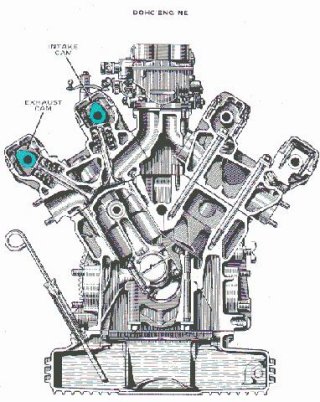 DOHC
stands for double overhead cam. A DOHC engine has two
camshafts per cylinder head, so inline engines have two cams, but V
engines have four. Usually, double overhead cams are used on engines
with four or more valves per cylinder -- a single camshaft simply
cannot fit enough cam lobes to actuate all of those valves. Of the
two cams, one drives the intake valves and the other operates the
exhaust valve. In a single overhead cam engine (SOHC), one cam has
enough lobes to drive both the intake and exhaust valves. DOHC is
also known as "twin overhead camshafts."
DOHC
stands for double overhead cam. A DOHC engine has two
camshafts per cylinder head, so inline engines have two cams, but V
engines have four. Usually, double overhead cams are used on engines
with four or more valves per cylinder -- a single camshaft simply
cannot fit enough cam lobes to actuate all of those valves. Of the
two cams, one drives the intake valves and the other operates the
exhaust valve. In a single overhead cam engine (SOHC), one cam has
enough lobes to drive both the intake and exhaust valves. DOHC is
also known as "twin overhead camshafts."
The main reason to use double overhead cams is to allow for more intake and exhaust valves. More valves means that intake and exhaust gases can flow more freely because there are more openings for them to flow through. This increases the power of the engine.
Vigo has four valves on each of its four cylinders (two valves for intake and two valves for exhaust), and this arrangement requires two camshafts per bank of cylinders, hence the phrase "dual overhead cams."
What is the advantage of four cylinders? A single cylinder provides only one power impulse every two crankshaft revolutions in a four-cycle engine. It delivers power only one-fourth of the time. To provide for a more continuous flow of power, modem engines use four, six, eight, or more cylinders. The same series of cycles take place in each cylinder. Vigo four cylinders keep firing one after another. The power strokes follow each other so closely that a continuous and even delivery of power goes to the crankshaft.
Double Cab
Double Cab is the term Toyota uses to describe its four-door pickup trucks. Also Known As: Crew Cab (Chevy, GMC, Nissan), Quad Cab (Dodge), SuperCrew (Ford)
Double Wishbone Suspension (A-Arm Suspension)
An independent suspension system in which each wheel is located on a "knuckle" that is connected by ball joints to upper and lower A-arms that are unequal in length. This system minimizes changes in track and camber during cornering and when driving over bumps. This suspension can also permit a lower fender height because of its compact design. Although slightly more common in front suspension, the double wishbone design is frequently used in the rear of high-performance and luxury cars. Most cars equipped with this type of suspension tend to sit lower to the ground.
Drivetrain
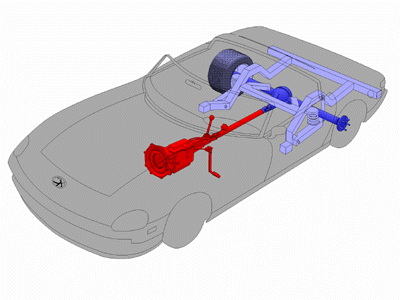
All of a car's components that create power and transmit it to the wheels; i.e. the engine, the transmission, the differential(s), the hubs, and any interconnecting shafts
Dry-disc clutch
In a car, you need a clutch because the engine spins all the time and the car wheels don't. In order for a car to sbest without killing the engine, the wheels need to be disconnected from the engine somehow. The clutch allows us to smoothly engage a spinning engine to a non-spinning transmission by controlling the slippage between them. To understand how a clutch works, it helps to know a little bit about friction. A clutch with only one plate is a dry clutch.
E
ECT
Electronically Controlled Transmission. Toyota's 4-speed ECT employs a computer to monitor driving conditions (speed, load, etc.) and your actions (throttle position, etc.) to maximize gear selection efficiency. It also networks with the engine computer for smoother shifting
Electronic Control Unit (ECU)
A digital computer that controls engine (and sometimes transmission, brake or other car system) functions based on data received from various sensors. Examples used by some manufacturers include Electronic Brake Control Module (EBCM), Engine Control Module (ECM), Powertrain Control Module (PCM) or Vehicle Control Module (VCM)
Electronic Fuel Injection (EFI)
Fuel injection has virtually replaced the carburetor in modern vehicles, taking on the job of mixing fuel with air before sending it to the engine's intake manifold. Electronic controls provide more precise measuring of both fuel and air to meet engine needs under a variety of circumstances. A computer uses a number of sensors to determine the amount and ratio of the mixture for best performance and economy under the current driving conditions. Benefit: The result is an engine that operates better in cold and hot temperatures, low and high altitudes and under varying load conditions. (See Throttle-Body Fuel Injection and Port Fuel Injection.) .
Electronically Controlled Automatic Transmission (ECT)
A sophisticated computer that monitors driving conditions (including speed, load and operating temperature) along with driver actions (throttle position) to efficiently control gear selection. Shift points are optimized for current driving conditions. Benefit: The result is smoother shifts for improved performance and fuel economy. Some ECT transmissions, including several Toyota models, incorporate driver-selectable shift modes. By setting the transmission on "normal" mode, the computer selects gears to optimize fuel efficiency. Benefit: A "power" mode allows higher engine rpm for sportier performance.
Electronic Throttle Control System with intelligence (ETCS-i)
Electronic Throttle Control with Intelligence (ECTS-i) replaces the cable operated manual throttle. The accelerator pedal position is sensed electronically and input into the ECM. The ECM then, according to elaborate programming, drives a small electric motor which opens/closes the throttle as required. The benefits of ECTS-i include; smoother acceleration/deceleration reduced shift shock and simplified engine control (replacing several devices for idle speed control, cruise control and traction control). The throttle cable remains (on some models) only to provide a failsafe function should the ETCS-i fail.
Engine Immobiliser
Prohibits fuel delivery and ignition if an attempt is made to start the engine with an invalid ignition key.
Benefit: Provides added security independently from other security systems. The engine immobilizer is a standard transponder type system. In this system, a transponder chip in the key head is recognized by the vehicle ECM. If no key, or an unregistered key is used the ECM prevents an ignition signal and a fuel injector control signal, therefore the engine will crank but not start. This system operates independently and does not rely on any other security system or the remote door locking system. Extra keys can be registered as long as an original master key is available
F
Fiberglass
A composite material that relies on small glass fibers for its strength. Fiberglass is commonly found on aftermarket body panels.
Four Valves Per Cylinder (4V)
A valvetrain with a total of four valves in the combustion chamber, typically two intakes and two exhausts. Compared to the more common two-valve-per-cylinder designs, a four-valve layout offers improved breathing and allows the spark plug to be located closer to center of the combustion chamber.
Four-by-Four (4X4)
Used to describe a vehicle with four-wheel drive. The first figure is the number of wheels, and the second is the number of powered wheels.
Four-by-Two (4X2)
Used to describe a vehicle with two-wheel drive. The first figure is the number of wheels, and the second is the number of powered wheels. Another term for two-wheel drive.
Four Wheel Drive (4WD)
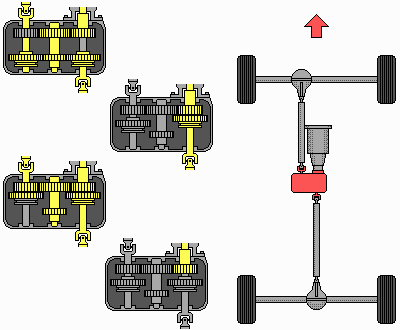
Four Wheel Drive (4WD) transfers engine power to all four wheels. 4WD systems usually lack a center differential that allows use in dry conditions. 4WD provides superior traction compared with front or rear-wheel drive.
Four Wheel Drive (4WD) - Part time
A part time four wheel drive system operates in two wheel drive mode until you choose to engage four wheel drive for off road or other adverse driving conditions.
Four Wheel Drive (4WD) - Permanent
Permanent four wheel drive sends torque to all four wheels on a continuous basis. There is no option for two wheel drive but the driver can usually choose a high or low mode depending on the driving conditions
Front Airbags (SRS)
Toyota's next-generation front airbags are provided for the driver and front passenger as standard equipment. The front airbag will not inflate in every collision. The airbags are designed not to deploy from rear end collision, vehicle rollover, and low speed frontal collision. In cases of side impact, the front airbags will not deploy, however on vehicles that are equipped with side airbags, the relevant side airbag will deploy.
Front-Engine/Front-Wheel Drive
Sometimes abbreviated "FF" or "FWD," this refers to a vehicle with the engine in front of the passenger compartment driving the front wheels. This layout is efficient in terms of packaging, providing more room for passengers and cargo by combining the entire drivetrain in one unit and eliminating the need for a driveshaft tunnel. Benefit: By placing the weight of the engine over the drive wheels, traction is also improved in certain situations.
Front-Engine/Rear-Wheel Drive
Abbreviated "FR" or "RWD," this is a layout in which the engine is in front of the passenger compartment and drives the rear wheels through a driveshaft that connects to the rear axle. Benefit: This provides benefits in weight distribution for improved handling in sports and luxury cars. It is also used in trucks to enhance load-carrying and towing ability; since the load-carrying area of the vehicle is over the driving wheels, traction is improved
Front Wheel Drive (FWD)
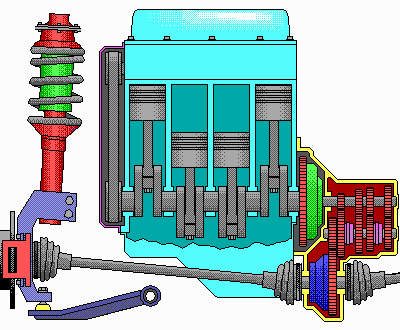
The front wheels receive engine power. FWD provides more traction than rear-wheel drive(RWD) in poor road conditions because more weight is over the drive wheels. FWD also allows better use of interior space than RWD because all drivetrain components are concentrated in the front of the car.
Fuel Injection
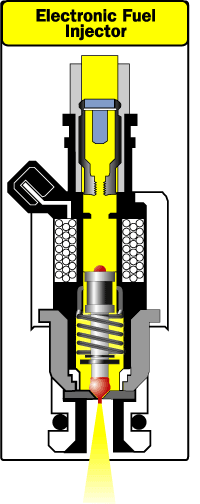 On internal-combustion engines, a system that injects a precisely
measured amount of fuel into the cylinder at exactly the right
moment. Dispenses with the carburetor and increases engine
efficiency. Fuel injection provides better metering of fuel and air
than carburetors. This results in more power, improved fuel economy,
and lower emissions. The simplest systems use single or dual
injectors in a central chamber to supply all cylinders. More
sophisticated systems use an injector at each cylinder to precisely
meter fuel. Any system that meters fuel to an engine by measuring
its needs and then regulating the fuel flow, by electronic or
mechanical means, through a pump and injectors. Throttle-body
injection locates the injector(s) centrally in the throttle-body
housing, while port injection allocates at least one injector for
each cylinder near its intake port.
On internal-combustion engines, a system that injects a precisely
measured amount of fuel into the cylinder at exactly the right
moment. Dispenses with the carburetor and increases engine
efficiency. Fuel injection provides better metering of fuel and air
than carburetors. This results in more power, improved fuel economy,
and lower emissions. The simplest systems use single or dual
injectors in a central chamber to supply all cylinders. More
sophisticated systems use an injector at each cylinder to precisely
meter fuel. Any system that meters fuel to an engine by measuring
its needs and then regulating the fuel flow, by electronic or
mechanical means, through a pump and injectors. Throttle-body
injection locates the injector(s) centrally in the throttle-body
housing, while port injection allocates at least one injector for
each cylinder near its intake port.
G
Gate-type Transmission
Gear Ratio
A gear ratio occurs when 1 gear drives another gear. For example, lets take two different size gears, one with 40 teeth and the other with 20. The one with 20 teeth will make two revolutions compared to one revolution performed by the gear with 40 teeth. This setup would create a gear ratio of 2:1. The driven gear (40 teeth) turns 1/2 the speed of the drive gear (20 teeth) but multiplies the torque by 2. The higher the ratio, 4:1 for example, the more torque will be created, but the slower the output speed.
Global Outstanding Assessment (GOA)
Toyota has developed a new vehicle body structure criteria which incorporates the results of these simulations and crash tests, as well as all current and foreseeable North American, Japanese and European crash safety standards. The result is one of the strictest crash test criteria standards in the industry, known as Global Outstanding Assessment, or GOA (pronounced go-ah). For example, in offset frontal collision tests, the accepted European standard is 56 km/h. To stress its vehicles further, Toyota tests them at 60 km/h (producing approximately 15 percent more energy).
GOA stands for Global Outstanding Assessment. Passive safety attempts to minimize injury to occupants in the case of a collision. Fundamental to passive safety is TOYOTA's world famous GOA Body. It employs an energy-absorbing structure with a crushable zone specifically designed to disperse impact energy throughout the rest of the structure, while keeping the reinforced cabin intact and protecting passengers.
Toyota's aim is to design all its new vehicles so they are the safest in their class in the world. They don't just want to meet the world's current tough safety requirements, but anticipate, then exceed tougher requirements of the future. It's a global view. Toyota's tests are based on the toughest of both the current and anticipated safety standards of Europe, Japan, Australia and the United States. The result is a unique benchmark of safety excellence known as Global Outstanding Assessment, or GOA (pronounced go-ah).
Based on actual crash data and extensive computer simulations, Toyota's GOA technology is assurance of increased protection in the event of an accident. In particular, GOA is the term applied to Toyota vehicle body structure and restraint systems, which have satisfied Toyota's own stringent test criteria.
GOA safety bodies also contribute to driver and passenger comfort whilst travelling. The impact absorption and dispersion qualities of the high integrity cabin also absorb and disperse energy that is created by forces arising from the car's contact with the road while driving. Computer aided engineering provides additional crash test information earlier. The result is that the unique GOA body structure produces enhanced road handling and increases resistance to the wear and tear of everyday driving.
The entire GOA programme ensures a complete approach to vehicle safety .
Gross Axle Weight Rating (GAWR)
The maximum amount of weight that can be supported by each axle, as designated by the manufacturer. What you need to know: The total load on each axle must not exceed its GAWR
Gross Combined Weight (GCW)
The total weight of a vehicle, including all its cargo, plus the weight of a trailer and its entire contents.
Gross Combined Weight Rating (GCWR)
The maximum allowable weight of the GCW as specified by the manufacturer. Exceeding this limit compromises safety. What you need to know: Vehicles that operate above the GCWR are a potential safety hazard because the engine, frame, suspension, brakes and tires are not designed for weight above the rating the manufacturer has set.
Gross Vehicle Weight (GVW)
Maximum legal weight at which a vehicle can be operated. The total weight of a vehicle with driver and passengers, cargo, fuel, coolant, any dealer or after-market installed accessories, and tongue weight if towing.
Gross Vehicle Weight Rating (GVWR)
It is the maximum permissible total weight of the vehicle that may not be exceeded, as designated by the manufacturer. GVWR is identified on the manufacturer's label, which is usually located on the driver's door or door jam. What you need to know: Vehicles that operate above the GVWR are a potential safety hazard because the engine, frame, suspension, brakes and tires are not designed for weight above the rating the manufacturer has set.
Ground Clearance
The distance between the lowest point on the vehicle and the ground. This number is particularly useful for 4-wheel-drive trucks and sport utility vehicles, which are more likely to encounter obstacles.
H
Halogen headlamps
Fluorine, chlorine, bromine, iodine, and astatine are called halogens. A halogen bulb gives off a bright light and contains a trace of a halogen, such as iodine. Halogen headlamps is a Tungsten-halogen bulb in sealed beam unit or as separate bulb in composite headlamp.
A halogen headlight is a high intensity reflector with inner halogen bulb, precision lens, and 3-prong attachment. Don't touch the glass of a halogen bulb with your fingers. The oil left on the glass will cause the glass to break or reduce the life of the bulb. If the glass is accidentally touched, it may be cleaned with methylated spirits or rubbing alcohol on a soft cloth.
Horsepower: (HP)
A measurement of the engine's ability to perform work. One horsepower is defined as the ability to lift 33,000 pounds one foot in one minute. To find horsepower, the total rate of work in foot pounds accomplished is divided by 33,000. If a machine was lifting 100 pounds 660 feet per minute, its total rate of work would be 66,000 foot pounds per minute. Divide this by 33,000 foot pounds per minute to arrive at 2 horsepower. In metric terms, it is the ability to raise 250 kilograms a distance of 30 centimeters in one second. It is also equal to 745.7 watts.
The measurement of mechanical power, or the work needed to carry a weight over a given distance in a specified period of time. The base measurement is 100 pounds carried 330 feet per minute. The combination can also be 1,000 pounds carried 33 feet per minute or 33 pounds carried 1,000 feet per minute etc. You can make whatever combination of feet and pounds you like- as long as you have 33,000 in one minute and you have horsepower.
I
Independent Suspension
Suspension in which each wheel is sprung individually so that any disturbance on the wheel has no effect on the opposite wheel. This compares to a "rigid" or "solid" axle where the wheels are connected and a disturbance at one end affects the other. Independent suspensions can apply to the front, rear or all four wheels.
Designed for off-road durability and on-road comfort, Vigo's suspension features coil springs and MacPherson struts in the front and a sophisticated double-wishbone in the rear for sure-footed handling and bump absorption. Fully-boxed front suspension arms and rugged hollow-cast steel rear A-arms improve durability. And the front ball-joint-type stabilizer bar helps minimize body lean on corners.
Benefit: Smoother, more controlled ride.
Inertia Fuel cutoff switch
This is a great safety feature. During collision, Vigo's computer will switch off ignition and cut off fuel supply
Intercooler
If you see Vigo's picture below, you will see Intercooler splashed in front of the vehicle with pride. An intercooler is a special radiator through which the compressed air is passed to cool it off before it enters the cylinder. Why is that such a big deal? In a turbocharged engine, air is compressed to allow more Oxygen into the cylinders. The more air you get in, more fuel you can get in. The more fuel you get in, the faster you can go. So far so good, but the problem is that when you compress the air, it becomes hot. If the incoming air is hot, it will expand less when combustion takes place. Enters intercooler to the rescue. Air from the turbocharger is routed to the intercooler. The cooled air enters the cylinders, allowing for greater compression and thus greater speed. Cooler air burns more easily. Therefore, many turbocharged and supercharged cars have an intercooler.
An intercooler allows more oxygen to
enter each cylinder on compression
and more oxygen in the motor you makes for a more powerful and
hotter combustion bang. Cooler air is denser and therefore
creates a bigger bang.
Cooler air = denser air mass = more powerful combustion = more power
Incoming intercooler cooled air cools the engine
and the cool oxygen rich air burns more efficiently (like your car on a cold day), then add more
fuel richening the mixture and warming the motor back up as more
fuel and air is combusted. End result is the engine operates still
at a safe temperature but has much more power as it has more bang on
compression.. exactly the same effect as the turbo forcing more air
in and adding more fuel.
Advantages to Intercooling
- Suppressing Engine Knock: Compressed air leaving a turbocharger is often more than 200° F. This warm air is much more prone to pre-detonation and auto-detonation (knocking) than air at ambient temperature and pressure. Knocking, if unresolved, can ultimately ruin an engine. There are several approaches to eliminating ping, including using higher octane fuel and cooling the compressed intake air. An intercooler can achieve the latter, reducing the likelihood of ping.
- Increasing Intake Air Density: Another advantage to cooling the compressed air is that the cooler air will also be more dense, which is the objective of turbocharging.
L
Leaf Spring
A number of slightly curved, flexible steel plates of varying lengths, mounted one abest the other. The plates are attached at the ends to the underbody. The curved shape of the plates allows them to flex and absorb bumps. Made of spring steel or various composite materials that deflects by bending when forces act upon it . Leaf springs are used primarily in suspensions. The ends are attached to the chassis, and the middle is fixed to the axle. Also called semi-elliptic springs.
Leaf Spring
A long, thin, narrow strip of steel, curved in a semi-elliptic arc and connected to the vehicle's frame at each end. Usually more than one strip of steel is used to form a multi-leaf spring. A few applications also utilize materials other than steel, such as a fiberglass/plastic composite. In the most common cases, such as in a Toyota truck, two multi-leaf steel springs are mounted longitudin-ally to form the rear suspension. Some vehicles use a transversely mounted single leaf spring or multi-leaf spring for the rear suspension. Both types of leaf spring suspensions are less commonly found in the front suspension. Rugged and simple in design, leaf springs are extremely flexible, able to be layered according to weight application and designed to support heavy loads.
Limited Slip Differential (LSD)
A differential that reduces speed differences between wheels. An LSD improves traction by preventing a slipping wheel from receiving all the engine power. The differential uses cone or disc clutches to lock the two separate axle shafts. This forces both driving wheels to transmit the same drive torque regardless of the traction available. It still allows differential action under normal driving conditions but improves traction in mud and snow. Limited slip ensures that some torque is always distributed to both wheels, even when one is on very slippery pavement.
Limited Slip Rear Differential
Distributes control power evenly to both driving wheels in slippery conditions to reduce one wheel from slipping or spinning.
Load-Sensing Proportioning Valve (LSPV)
A valve that monitors the weight distribution of a vehicle and automatically adjusts the front/ rear distribution of brake force to maximize rear brake performance.
M
Manual Transmission
A transmission consisting of a gearbox and clutch. The driver depresses the clutch to disengage the engine from the gearbox, allowing a shift lever to be moved. The shift lever selects the gears to be meshed in the gearbox, varying the gear ratio according to the driver's choice. This allows the driver to have more direct control over gear selection, which provides a better "feel" for sport-minded people and improved fuel efficiency. Benefit: Since a manual transmission has a direct mechanical link, rather than a hydraulic link, found in an automatic transmission, there are fewer friction losses, providing better acceleration and/or fuel efficiency under most conditions..
Multi-Reflector Headlamps
These new lamps utilize a halogen bulb which gives off an 18 percent brighter light, and is 5 percent closer to natural light. The reflectors are designed to focus the light beams, rather than the lens. Benefit: Spread light more evenly across the road and give the vehicle a cleaner look due to their crystalline appearance.
Multi-Valve
Traditional piston engines normally have one intake valve and one exhaust valve, a total of two per cylinder. A multi-valve engine increases this number. Many vehicles, including all current Toyota vehicles, have four valves per cylinder: two intake and two exhaust. There are also engine designs with three valves per cylinder (two intake and one exhaust) and a very few high-performance racing engines with as many as five valves per cylinder (three intake and two exhaust). Benefit: The advantage to multiple valves is the ability to increase the flow of the fuel and air mixture into and out of the cylinders, particularly at high rpms, while centrally locating the spark plug for a more even combustion. A multivalve engine can attain higher rpms while providing more power and greater fuel efficiency.
O
Overdrive
A final drive ratio of less than 1:1. This allows the engine to operate at lower rpm during highway driving, requiring less fuel and reducing engine noise.
Overhead Cam (OHC)
This is when the camshaft is located in the cylinder head, rather than in the engine block (see Camshaft).
Benefit: This design eliminates the need for pushrods and lifters, reducing weight and improving engine responsiveness and efficiency. The advantages tend to increase at high rpm.
P
Payload
The maximum amount of weight, including driver and passengers, that can be carried in the truck's bed and cabin. Basically, the payload is the GVWR minus the Curb Weight.
Power Steering
A steering system assisted by hydraulic or vacuum pressure from a pump. This reduces steering effort. Power steering is essential to make large, heavy vehicles manageable. Small vehicles often do not require power steering.
Benefit: Power steering multiplies the driver's steering force and lessens the amount of steering input required to turn the wheels.
Power-to-Weight Ratio
The horsepower rating of an engine divided by the vehicle's curb weight. The resulting number is the number of pounds of vehicle per horsepower. With other factors being equal, the fewer pounds per horsepower the higher the performance. For example, a vehicle with a ratio of 1:15 (one horsepower to 15 pounds of curb weight) should accelerate much more quickly than one with a ratio of 1:30.
Powertrain (Drivetrain)
A name given to the components that create power and send it to the driving wheels, including the engine, transmission, driveshaft, differential and axle(s).
R
Revolutions per minute (rpm)
RPM indicates how many times the engine crankshaft rotates per minute. Vigo's 1KD engine develops 120kW (163D|N hp) at 3,400 rpm while 2KD develops 75 kW at 3600 rpm. If the engine is running at 4,000 RPM, the valves are opening and closing 2,000 times every minute, or 33 times every second.
Rack-and-pinion Steering
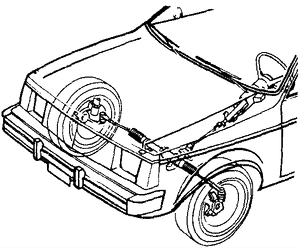 A steering system having a pinion gear at the lower end of the
steering column that engages a rack or a toothed rod that connects
to the wheel steering arms. The ends of the rack are linked to the
steered wheels with tie rods. When the gear is rotated by the
steering shaft, it moves the rack from side to side: turning the
wheels.
A steering system having a pinion gear at the lower end of the
steering column that engages a rack or a toothed rod that connects
to the wheel steering arms. The ends of the rack are linked to the
steered wheels with tie rods. When the gear is rotated by the
steering shaft, it moves the rack from side to side: turning the
wheels.
The steering wheel is connected to a pinion gear that meshes with a rack, or linear gear. As the pinion rotates, the rack moves side to side, this moves the steering linkage, causing the wheels to pivot left or right.
A steering system common to many passenger vehicles. This type of steering consists of a round pinion gear attached to the steering shaft, and a flat bar with gear teeth cut into it, called the rack. The rack and pinion mesh at a point between the front wheels. As the steering wheel is turned, the shaft from the steering column turns the pinion gear forcing the rack either right or left along a horizontal plane. The rack is linked to the wheels via tie rods, which push and pull the wheels to make them turn.
Benefit: In general, rack-and-pinion steering provides a sporty feel to the steering.
Rigid Axle
A simple non-independent suspension, consisting of a rigid transverse member with wheel hubs solidly bolted to it. The axle can be attached to the body by leaf springs, or by a combination of suspension arms and links.
S
Semi-elliptic leaf spring
A slightly curved leaf spring that is attached to a car's body at its ends and to a suspension component near its middle. One of the two body attachments is a shackle, which allows for changes in the spring's length as it flexes up and down.
Side Impact beams
Steering Ratio
The ratio of the gearing within a steering system, such as the rack to the pinion or the interfacing and worm gear to the recirculating-ball and nut. A smaller ratio (such as 4:1, compared to 6:1) means that the front wheels turn more tightly in response to steering input, a condition normally associated with sporty vehicles. A larger ratio means that the steering responds more subtly.
Supplemental Restraint System (SRS) Airbags
The airbag is not intended to be used alone. It is a supplementary safety feature, which works together with driver and front passenger's seatbelts to provide additional protection in high-speed frontal collisions. Therefore, it is important that seat belts be worn at all times while the vehicle is in motion or momentarily stopped. Airbags are made of strong nylon cloth and are effective in reducing injury to the head and chest of the driver and passenger. Airbags inflate with considerable force and speed, so while they reduce serious injuries, the SRS airbags could cause minor skin redness or abrasions.
Suspension
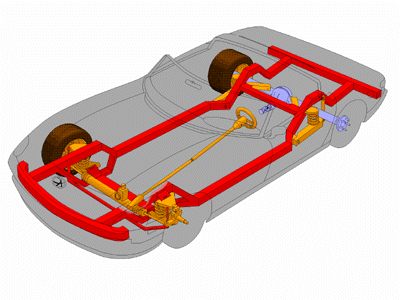
The assembly of springs, shock absorbers, torsion bars, joints, arms, etc., that cushions the shock of bumps on the road and serves to keep the wheels in constant contact with the road, thereby improving control and traction.
T
Torque
Is a force that tends to rotate or turn things. For example, you generate torque anytime you apply a force using a wrench. When you use a wrench, you apply a force on the handle. This force creates a torque on a nut, which tends to turn the nut. To calculate the torque, you just multiply the force by the distance from the centre. In the case of the nut, if the wrench is a foot long, and you put 200 pounds of force on it, you are generating 200 pound-feet of torque. If you use a two foot long wrench you only need 100 pounds of torque on it to generate the same torque. So by lengthening the wrench, you have multiplied the torque (same as a lever). In an engine, torque is the twisting motion at the crankshaft in foot-pounds. What you need to know: Torque gets it going, and horsepower keeps it going
It is thus a measure of the twisting force. Torque is measured in lb.-ft. (pound-foot) or N-m (Newton-meters). The RPM at which the engine produces maximum torque is important. For instance, if Engine A produces 200 lb.-ft. @ 3000 RPM, and Engine B supplies 200 lb.-ft. @ 5000 RPM, then Engine A will accelerate better at low speeds. Engine B will accelerate better at high speeds.
Torsion Bar
A type of spring that twists as it is compressed or stretched. Torsion bar springs are simple and rugged, used in the suspension system.
Torsion Bar Spring
A basically straight bar fastened to the frame at one end and to the control arm of the suspension at the other end. The bar acts as a spring as it resists twisting when the wheel moves up and down. Benefit: The advantages are relatively low weight, no wear and maintenance and, in some vehicles, packaging advantages.
Torsion Bar suspension
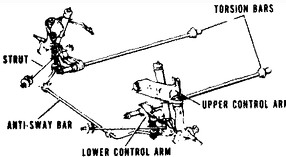 Long
rods of spring steel which take the place of springs. One end of the
bar is anchored and the other arm (attached to the suspension) is
free to twist. The bars' resistance to twisting causes springing
action.
Long
rods of spring steel which take the place of springs. One end of the
bar is anchored and the other arm (attached to the suspension) is
free to twist. The bars' resistance to twisting causes springing
action.
Torsion Beam Suspension
Also called a Twist Beam Suspension, this is a rigid axle design. The cross member acts as a torsion bar to resist twisting of the suspension arms. The result is increased roll rigidity and a very small positive camber angle during cornering. Benefit: The compact design offers good space utilization and lower weight than most other rigid axle designs.
Toyota Computer Controlled System (TCCS)
A system used in all Toyota vehicles that monitors a variety of factors, including engine speed, engine temperature, air temperature and engine load. This information is sent to a sophisticated computer which then coordinates adjustments to the fuel injection and ignition systems. Benefit: This technology can optimize engine operation for low emissions, best performance and efficient operation under varying driving conditions.
Toyota Direct Ignition (TDI)
Direct ignition provides an individual ignition coil for each spark plug. Benefit: This eliminates the distributor and ignition wires, along with the need to adjust ignition timing. It also ensures delivery of a high voltage spark at just the right moment.
Traction
Transmission
The gear-changing or gear-shifting system through which engine power is transferred to the wheels. The purpose of gear-changing is to keep maximum engine power applied to the wheels at all times for all conditions, from start-up to high speeds. Most transmissions have 3-6 ratios or "speeds". The engine (via the crankshaft) spins too fast to drive the wheels. The transmission "reduces" the RPM and allows the engine to drive the wheels. Manual transmissions or "stick shifts" use gears as described above. Automatic transmissions usually employ turbines and a fluid to transmit power to the wheels. The rotational motion of the fluid through the transmission transfers the power from the crankshaft to the wheels. The different transmission ratios are needed to keep the engine operating efficiently. The lower ratios (ex. 1st and 2nd gears) provide the maximum torque (or twisting force) to move the car from a standstill. The higher ratios (ex. 4th and 5th gears) allow lower engine RPM for highway speeds. Generally speaking, the fewer ratios a transmission has, the less efficiently the engine operates.
Turbocharger
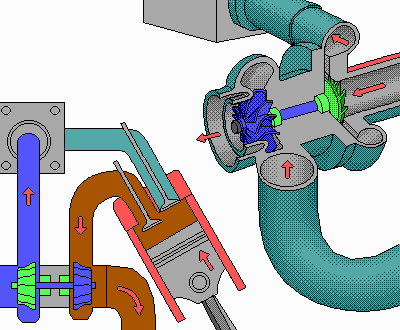 What it is: A Turbocharger is a type of Supercharger that
is powered by engine exhaust gas. It increases engine power by
pressurizing intake air into the cylinders.
What it is: A Turbocharger is a type of Supercharger that
is powered by engine exhaust gas. It increases engine power by
pressurizing intake air into the cylinders.
Turbochargers are a type of forced induction system. They compress the air flowing into the engine. The advantage of compressing the air is that it lets the engine squeeze more air into a cylinder, and more air means that more fuel can be added. Therefore, you get more power from each explosion in each cylinder. A turbocharged engine produces more power overall than the same engine without the charging. This can significantly improve the power-to-weight ratio for the engine. In order to achieve this boost, the turbocharger uses the exhaust flow from the engine to spin a turbine, which in turn spins an air pump. The turbine in the turbocharger spins at speeds of up to 150,000 rotations per minute (rpm) -- that's about 30 times faster than most car engines can go. And since it is hooked up to the exhaust, the temperatures in the turbine are also very high.
A supercharging device driven by exhaust gases from the engine. The turbine, driven by hot gases in the exhaust manifold spins the compressor. The compressor increases the intake air density, and combined with additional fuel, produces more power. Turbochargers always use centrifugal-flow compressors, which operate efficiently at the high rotational speeds produced by the exhaust turbine.
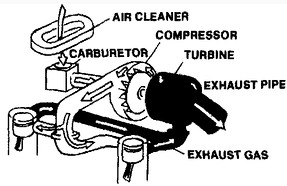 How it works: Turbochargers are centrifugal compressors
powered by an exhaust gas-driven turbine. The turbine and compressor
are on opposite ends of single rotating shaft fitted in the
turbocharger housing. The shaft runs at speeds up to about 100,000
rpm. An advantage over the mechanically driven supercharger is
better fuel efficiency because it does not use direct crankshaft
power. The disadvantage of the turbocharger is turbo-lag (slow
speedup of the compressor from a closed throttle), resulting in
longer time to boost compressor pressure and slow engine response.
Some customers dislike this lag.
How it works: Turbochargers are centrifugal compressors
powered by an exhaust gas-driven turbine. The turbine and compressor
are on opposite ends of single rotating shaft fitted in the
turbocharger housing. The shaft runs at speeds up to about 100,000
rpm. An advantage over the mechanically driven supercharger is
better fuel efficiency because it does not use direct crankshaft
power. The disadvantage of the turbocharger is turbo-lag (slow
speedup of the compressor from a closed throttle), resulting in
longer time to boost compressor pressure and slow engine response.
Some customers dislike this lag.
Customer benefit: increased power.
Two-wheel Drive (2WD)
4 x 2 (2WD) - Refers to a two-wheel drive vehicle with four wheels. The first figure is the number of wheels. The second is the number of powered wheels. With a 4x2, engine power is transmitted to only two wheels, usually the rear.
Urethane
V
Valve Train
The system that operates intake and exhaust valves, consisting of camshaft, valves and springs, lifters, pushrods and rocker arms.
Variable Valve Timing (VVT)
What it is: Variable Valve Timing allows the point at which an engine's valves open and close to change with operating conditions - such as engine speed and throttle position. in addition to changing the valve timing with respect to the crankshaft, some systems also change the duration the valve is open and the extent to which it opens. Varying these parameters allows the engine to operate more efficiently at all engine speeds while maintaining driveability.
How it works: Traditionally, camshafts open and close intake and exhaust valves at fixed points in the engine cycle regardless of engine speed or throttle position. Variable Valve Timing can employ several mechanisms to change valve opening and closing. it can affect either the intake valves and/or the exhaust valves, depending on the design. Some methods include advancing or retarding the cams or valves or activating additional camshafts or rocker arms.
Customer benefit: Improved power, fuel economy and emissions (depending on the system).
VVT-i
VVT-i and VVTL-i technology represents a major step forward in engine performance and fuel efficiency, and confirms Toyota as a world leader in high efficiency, low emission engine technology. Due to technological constraints, in the past it was not possible for an engine to achieve 'high engine output', 'low fuel consumption' and 'clean exhaust gases'. However, these qualities have now been made possible through the adoption of the VVT-i and VVTL-i systems. VVT-i (variable valve timing – intelligent) uses a sophisticated computer system to control valve timing and ensure a constantly variable valve overlap. The result is higher torque output at all engine speeds, improved fuel efficiency, and reduced carbon monoxide, hydrocarbon and oxides of nitrogen emissions. Vehicles equipped with VVT-i systems are not only more responsive and easier to drive, they offer better performance than comparable vehicles of the same engine size.
In ordinary engines the relationship between inlet and exhaust valve opening and closing is non-adjustable because it is dependent upon their direct connection to the camshafts.
Engine designers have known for a long time that they could get better performance out of an engine under certain circumstances by allowing the intake valve to open slightly before the exhaust valve closes. This increases the time for the fuel/air mixture to enter the cylinder during the intake stroke. In this condition the exhaust and intake valves are open at the same time; this is called 'valve overlap'. In conventional engines 'valve overlap' timing is fixed.
- Fixed valve overlap allows the engine to perform well within a certain rev range, however there are three main undesirable side effects.
- Fuel is wasted – the fuel/air mixture is not always efficiently burned and this causes unburnt fuel to pass through the engine.
- Higher levels of undesirable exhaust emissions are produced.
- Power output potential is not fully realised.
Variable valve timing allows the relationship between the separate inlet and exhaust camshafts to vary the valve timing overlap. In doing so it overcomes the side effects described above by using a computer to continuously vary the intake valve timing and overlap. The valve timing and overlap are adjusted through a series of simple mechanisms to ensure the optimum conditions apply across all the working rev range. The advantages are lower fuel consumption, lower exhaust emissions and higher power output. Because the system is continuously variable, an 'i' for 'intelligent' has been added to the acronym.
Improves fuel economy, torque performance and reduces emissions. During some operating conditions, an engine is most efficient when the intake and exhaust valves are open at the same time - a condition known as "valve overlap". "Valve overlap" allows the engine to take advantage of the fluctuating port pressure which, depending on engine speed and load, can: Help draw additional air/fuel mixture for increased power. Reduce the power required to perform the intake stroke (pumping loss) providing increased fuel economy. Introduce some exhaust gases back into the intake air/fuel mixture to be reburnt, improving fuel emissions.
Variable Valve Timing and Lift with intelligence (VVTL-i)
Controls the intake and exhaust camshafts and the cam changeover mechanism to optimize valve timing and valve lift in accordance with engine conditions. Variable Valve Lift employs two-stage lift & duration profiles for intake & exhaust cams. Each pair of valves has one cam lobe for low-rpm operation; and one high-lift, long-duration lobe for high-rpm. VVTL-i opens up a new area of performance from 6000 rpm to the redline at 8400 rpm on the 2ZZ-GE engine
W
Weight Distribution
Expressed as two numbers, one front and one rear, this figure represents the percentage of weight resting on the front and rear axles. Benefit: A more even weight distribution aids in handling, and is important to the service life of many components, including axles, springs, bearings and tires.
Wheel Size (e.g. 15 X 7)
Wheel size is defined by the diameter and width of the wheel. A 15 X 7 wheel has a 15-inch diameter and a 7-inch width
Wheelbase
The distance from the center of the front wheel to the center of the rear wheel as viewed from the side of the vehicle.
Benefit: A longer wheelbase generally contributes to a smoother ride, while a shorter wheelbase results in a tighter turning radius
Wishbone Suspension (Double Wishbone Suspension)
An independent suspension that uses curved members (wishbones) to control suspension travel. A wishbone suspension offers good axle control, and limits undesirable suspension.
© 2002-2009 :: Sam Automotive Group :: All rights reserved :: Email: thai4x4@gmail.com ::
